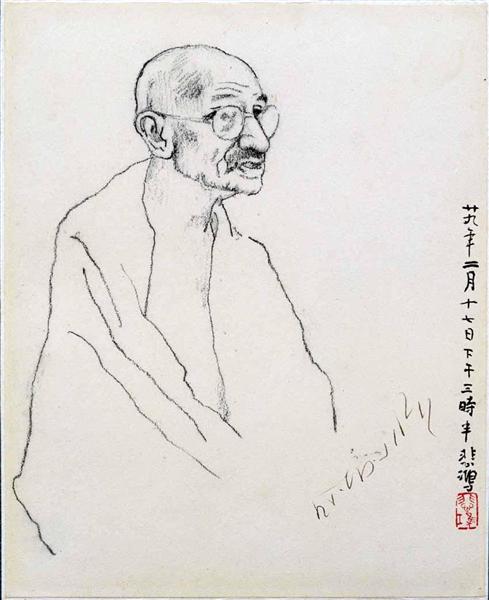Description
Xu Beihong, one of the greatest exponents of contemporary Chinese painting, gives us in "portrait of Mahatma Gandhi" a significant work both in its technique and in its deep cultural and historical content. Beihong, known for his ability to merge the styles of Western and Eastern art, is presented here as a master that not only captures the essence of its model, but also the values it represents.
In this painting, Beihong faces the task of portraying one of the most iconic characters of the twentieth century: Mahatma Gandhi. The representation is sober and solemn, in line with the figure of the Indian leader. Gandhi, a central figure of the India Independence Movement and an apostle of non -violence, is presented in a contemplative pose. The serene and reflective expression in his face seems to capture, simultaneously, the simplicity of his life and the depth of his intellect.
Beihong uses a limited palette of colors, mostly terrible and white tones, to approach the austerity that characterized Gandhi's life. The soft and sober colors highlight the whiteness of the Dhoti, the traditional garment that Gandhi adopted as a symbol of his commitment to the Indian local culture and economy. The simplicity of the costumes contrasts with the complexity of the emotions and thoughts that Beihong manages to transmit through the eyes and factions of the mahatma.
The composition of the work is simple but effective. The portrait is centered, which obliteratedly leads the spectator directly to Gandhi's face. There are no distractions in the background, which underlines the importance of the central figure. This minimalist approach is characteristic of Beihong, who often sought the essence more than the form in his portraits. The almost total absence of additional elements highlights the figure of the portrayed, allowing us a more intimate encounter with Gandhi.
Beihong's technique in color and texture application is also remarkable. The safe and fluid strokes reflect their dominance of both oil and classic Chinese techniques, creating a bridge between the East and West in their work. The subtly rough texture of the canvas adds a touch dimension that breaks with the two -dimensionality of the paint, giving it an almost tangible presence to the portrait.
Although we do not know many specific and contextual details of this particular work, it is possible to place it within the corpus of Xu Beihong, an artist who was not only influential in the field of modern Chinese painting, but also played an important role as an educator and promoter of art at a global level. His portraits not only photographed the faces, but they also tried to immortalize the spirit of the subject, and in the case of Gandhi, he captured the essence of a man who dedicated his life to peace and justice.
"Mahatma Gandhi portrait" is thus a simple representation; It is a dialogue between two cultures, two worlds, which are found in the figure of a man whose life and work transcends time and space. Through the expert gaze and the master brush of Xu Beihong, we are invited to reflect on universal values such as dignity, resistance and humanization.
KUADROS ©, a famous paint on your wall.
Hand-made oil painting reproductions, with the quality of professional artists and the distinctive seal of KUADROS ©.
Art reproduction service with satisfaction guarantee. If you are not completely satisfied with the replica of your painting, we refund your money 100%.

